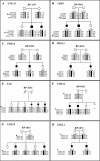Mutation analysis of 272 Spanish families affected by autosomal recessive retinitis pigmentosa using a genotyping microarray
- PMID: 21151602
- PMCID: PMC3000238
Mutation analysis of 272 Spanish families affected by autosomal recessive retinitis pigmentosa using a genotyping microarray
Abstract
Purpose: Retinitis pigmentosa (RP) is a genetically heterogeneous disorder characterized by progressive loss of vision. The aim of this study was to identify the causative mutations in 272 Spanish families using a genotyping microarray.
Methods: 272 unrelated Spanish families, 107 with autosomal recessive RP (arRP) and 165 with sporadic RP (sRP), were studied using the APEX genotyping microarray. The families were also classified by clinical criteria: 86 juveniles and 186 typical RP families. Haplotype and sequence analysis were performed to identify the second mutated allele.
Results: At least one-gene variant was found in 14% and 16% of the juvenile and typical RP groups respectively. Further study identified four new mutations, providing both causative changes in 11% of the families. Retinol Dehydrogenase 12 (RDH12) was the most frequently mutated gene in the juvenile RP group, and Usher Syndrome 2A (USH2A) and Ceramide Kinase-Like (CERKL) were the most frequently mutated genes in the typical RP group. The only variant found in CERKL was p.Arg257Stop, the most frequent mutation.
Conclusions: The genotyping microarray combined with segregation and sequence analysis allowed us to identify the causative mutations in 11% of the families. Due to the low number of characterized families, this approach should be used in tandem with other techniques.
Figures


References
-
- Wright AF, Chakarova CF, Abd El-Aziz MM, Bhattacharya SS. Photoreceptor degeneration: genetic and mechanistic dissection of a complex trait. Nat Rev Genet. 2010;11:273–84. - PubMed
-
- Hjortshøj TD, Grønskov K, Philp AR, Nishimura DY, Riise R, Sheffield VC, Rosenberg T, Brøndum-Nielsen K. Bardet-Biedl syndrome in Denmark-report of 13 novel sequence variations in six genes. Hum Mutat. 2010;31:429–36. - PubMed
-
- Jaijo T, Aller E, García-García G, Aparisi MJ, Bernal S, Avila-Fernández A, Barragán I, Baiget M, Ayuso C, Antiñolo G, Díaz-Llopis M, Külm M, Beneyto M, Nájera C, Millán JM. Microarray-based mutation analysis of 183 Spanish families with Usher syndrome. Invest Ophthalmol Vis Sci. 2010;51:1311–7. - PubMed
Publication types
MeSH terms
Substances
LinkOut - more resources
Full Text Sources
Miscellaneous
